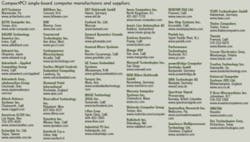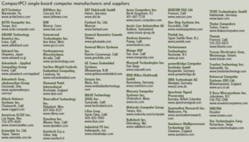By John Keller
Systems designers who use CompactPCI single-board computers for military and aerospace applications are turning to the relatively small 3U CompactPCI boards in a big way, industry experts say.
The reasons for the migration to 3U CompactPCI involve the 3U board’s relatively small size and weight, its inherent ruggedness, and its advantages in cooling, experts say.
“Most of what we are doing is driven by airborne applications where weight, power, performance, and cost are concerned,” says Frank Willis, military aerospace segment leader for single-board computer vendor GE Fanuc Embedded Systems in Albuquerque, N.M.
Engineers who are designing electronics for manned and unmanned aircraft must “put more stuff in a smaller package, so 3U is much more significant in what we are doing,” Willis says. “We are still doing a lot of 6U, but it is overshadowed by what we are doing in 3U,” which Willis says is “driving things into smaller packaging, where designers can get benefits in cost, weight, and performance.”
3U CompactPCI boards are smaller than their larger 6U cousins. The 3U boards measure about 6.3 inches by slightly less than four inches, while 6U boards measure about nine inches by 6.3 inches.
Not only are the smaller-size boards attractive for tight-fitting applications such as unmanned aerial vehicles, but they also are less susceptible to shock and vibration than are the 6U boards, and because of their smaller surface area are easier to cool, experts point out.
The CompactPCI standard did not begin life with a goal of becoming strong in the 3U form factor. In fact many experts originally believed that 6U would be the dominant size for CompactPCI to match the popularity of its single-board-computer competitor, 6U VME.
“When compact PCI was first ratified in 1995 it was defined for 3U and 6U form factors, and almost immediately 6U became the popular form factor and 3U was a small niche market largely in instrumentation,” explains Joe Pavlat, president and chairman of the PCI Industrial Computer Manufacturers Group (PICMG) in Wakefield, Mass.
“Starting four or five years ago the military guys who wanted the higher speed of PCI for imaging, radar, and video displays started using 3U CompactPCI if they needed components to fit in a small ATR box,” Pavlat says. “The advantage is the smaller board; it is inherently better on shock and vibration, and easier to cool.”
Pavlat points to several military and aerospace applications of 3U CompactPCI single-board computers from companies such as GE Fanuc, the Curtiss-Wright Controls Embedded Computing Group in Leesburg, Va., and Aitech Defense Systems in Chatsworth, Calif., that offer 3U CompactPCI for hardened military applications that require conduction-cooling and even space-grade radiation hardness.
Pavlat highlights a 3U CompactPCI application by GE Fanuc for the Predator unmanned aerial vehicle in which GE Fanuc engineers replaced a large VME box with flight control, communications, and other avionics with four smaller boxes that together weighed less than the original VME box.
One of the biggest advantages of the four-box solution is its elimination of the need to requalify all components in a large box when engineers make changes or upgrades. “That way when they changed the sensor package, they only had to requalify one box,” Pavlat says.
“3U CompactPCI has been around for a while now and has built up some traction,” says John Wemekamp, chief technology officer at Curtiss-Wright Embedded. Until now designers essentially have had no standard alternative to CompactPCI if they must use the 3U form factor, he says.
3U VME has had difficulty finding popularity in defense and aerospace applications because of bandwidth limitations on its small connector. Wemekamp says the new generations of high-speed serial networking may change that, but 3U CompactPCI still retains its popularity.
“It’s all about miniaturization,” Wemekamp points out. “We can squeeze more onto these form factors. The trend is squeezing more capability into a smaller-size footprint-whether it is PowerPC or Intel Pentium.”
null




